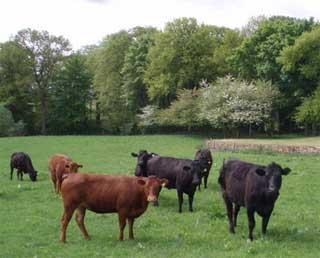On-Farm Assessment of Soil Carbon Status
Published on 4 September 2014 in Sustainability and Communities , Food, health and wellbeing

Introduction
Soil Organic Matter (or soil carbon) is of significant importance, in terms of soil fertility, water retention, structure and biodiversity. Furthermore, soil carbon is of importance to the Scottish Government’s goals for climate change mitigation, therefore it is critical to ensure that the large amount of carbon currently stored in Scotland’s soil is protected and retained.
Although many farmers routinely test their soil for pH, lime, phosphorus and potassium, most farmers do not specifically measure soil carbon, despite increasing attention from policy-makers and benefits to soil health.
Laboratory analysis is expensive given the number of samples required per farm to provide an accurate overview.
Using soil colour as an indicator of soil carbon concentrations is proposed as a cheaper, quicker, robust and in situ alternative testing option. The use of soil colour testing in combination with the website Soil Information for Scottish Soils, will enable land managers to compare their own soil carbon concentrations against average for a given soil type.
This project aimed to understand the level of farmer awareness, and to raise awareness, of how farmers consider and prepare for possible future initiatives and legislation related to protecting and increasing soil carbon, and how they might use soil carbon information to benefit their businesses.
Key Points
- Farming participants were motivated to learn about soil carbon, as they are inherently interested in soil, hence their agreement to participate and return a soil sample.
- Farming participants expressed confusion regarding the use of the term ‘soil carbon’ as opposed to ‘soil organic matter’, the latter being more commonly used by farmers.
- Current soil management practices undertaken by the farming participants include soil testing, applying organic matter to the soil (for example, dung), chopping and ploughing to incorporate straw, and crop rotation.
- Whilst farmers are seeking soil health more generally, they are acting to protect soil carbon without knowledge or realisation of this outcome.
- Barriers to increasing soil carbon include restrictions in Nitrate Vulnerable Zones to the application of organic matter, the cost of certain soil management techniques, weather, and other uncertainties, such as the risk of cattle diseases. Further barriers are the perceived inability to change farming practices to improve soil carbon levels, due to existing high soil carbon concentrations or the need to retain straw for livestock, and a lack of knowledge and practical ideas regarding how to increase carbon storage and protect carbon in soils.
- Farming participants had never previously determined the carbon concentrations in their soils, and given the fact that many had never heard of soil carbon testing, they questioned whether other tests exist of which they are not aware. Soils may be tested to assess and identify soil problems, detected through crop failure or a lack of cattle growth. Soil testing can also occur on an annual basis and fertiliser inputs adjusted accordingly, therefore utilised as a management tool to maximise yield.
- The colour-based soil carbon testing approach was considered likely to be cheaper (following initial technology cost on the part of the farmer if they do not already own a smartphone), more accessible, quicker and easier. More frequent soil testing can be undertaken, facilitating greater understanding by farmers of their soil, in turn improving soil health and yield.
Research Undertaken
This project was conducted in four stages:
- (i) farming participant recruitment
- (ii) on-farm soil sampling and analysis
- (iii) a knowledge exchange workshop attended by both farming participants and soil scientists
- (iv) a series of follow-up interviews with farming participants.
In parallel, an application for smart phones was developed based on the colour-based testing approach for soil carbon. This was demonstrated at the knowledge exchange workshop held in October 2012, as well as the functions and content of the SIFSS website.
Policy Implications
- Farming participants asserted the importance of financial incentives, in order to change farming practices to improve soil carbon concentrations, and suggested that ideally payments would be administered on an area basis. However, it was also recognised that it is in the interest of farming businesses to adopt carbon improvement measures, given the simultaneous benefits for soil fertility and thus production. Nonetheless, participants suggested that further incentives would be to cover the costs of additional soil tests (including testing for soil carbon), as well as accompanying information and interpretation. The provision of advice and practical ideas for increasing soil carbon was also noted as a necessary incentive, as well as further research on how best to measure and sequester carbon in soils.
- There was also a divide amongst interviewees between those who would be interested in participating in a carbon market, and those who are not sure or unconvinced. Interviewees explained that participation would depend on the level of interference with or benefit to current farming systems, the need for more knowledge and understanding of the mechanics of the carbon market system, as well as an accountable system with minimal administrative requirements. Others were sceptical given the perceived financial benefits to the market agent, and remain unconvinced that the system is possible on the farm scale, with anticipated difficulties of calculating carbon allocations.
- Legislation or further regulation is anticipated by farming participants that will require farmers to maintain or increase soil carbon, for example, within the new Common Agricultural Policy. Farming participants describe a sense of being overwhelmed with current legislation, and feel they have little say in policy development. Finally, there was a perception that carbon is the ‘wrong priority’, given the predicted global food shortage.
This project was funded by Quality Meat Scotland and undertaken from September – December 2012.
Author
Dr Annie McKee, James Hutton Institute annie.mckee@hutton.ac.uk
Topics
Sustainability and Communities , Food, health and wellbeing





